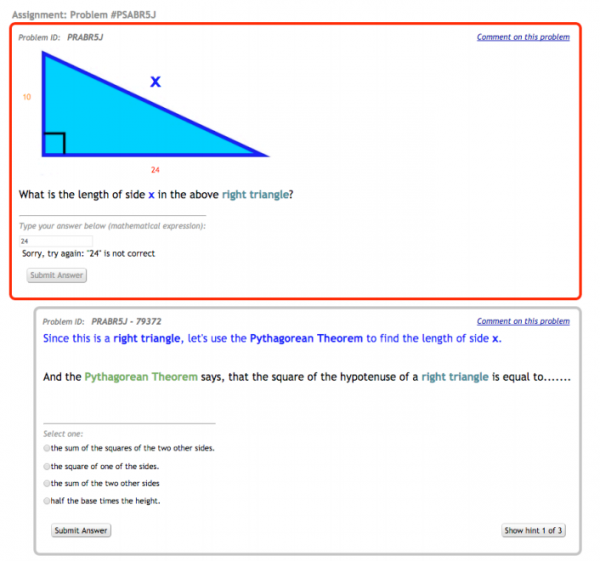Scaffold Problems with Guide Questions
| Scaffold Problems with Guide Questions | |
| Contributors | Paul Salvador Inventado, Peter Scupelli |
|---|---|
| Last modification | June 6, 2017 |
| Source | Inventado and Scupelli (2016).[1] |
| Pattern formats | OPR Alexandrian |
| Usability | |
| Learning domain | |
| Stakeholders | |
Ask students to answer guide questions that may help them recall prior knowledge or make inferences necessary to solve a problem.
Context
Students are answering a multi-step math problem in an online learning system. By multi-step problems we mean math problems whose solution involves the application of a series of processes. For example, solving for the hypotenuse of a triangle requires multiple steps such as: (a) recall the Pythagorean equation, (b) substitute the value of the triangle’s sides in the equation, (c) square the values of the sides, (d) add the squared values, and (e) get the square root of the sum.
Problem
Some students are unable to solve a problem because they may have forgotten or got confused about a concept or step in the solution process.
Forces
- Recalling prior knowledge. Students need to retrieve prior knowledge from long-term memory to utilize it in the working memory[2]. Various factors may hinder prior knowledge retrieval such as limited knowledge of related concepts, poor representation of the concept in memory, or lack of familiarity.
- Availability bias. When students do not know how to solve a problem they may apply processes that they remember worked on previous problems[3].However, applying the wrong process on a problem and failing to solve it may affect students’ motivation.
- Limited working memory. The amount of information that can be held in memory while performing a task is limited[3]. This makes it difficult to perform processes that consist of multiple concepts and steps.
Solution
Therefore, ask students to answer guide questions that may help them solve the problem. Guide questions can be used to help students recall information they need to solve the current step or recall the next step. For example, a multiple-choice question can help students recall the Pythagorean equation without necessarily giving away the answer. Guide questions may be asked to help students make inferences on the information they have available. For example, students could be asked how a given triangle’s sides maps into the Pythagorean equation. The process of guiding students toward the solution is often called scaffolding because students are provided temporary support as they build their understanding of the concept. As students gain more experience solving the same problem type, students can be given less support (i.e., remove scaffolds) or given more complex problems such as what is described in the Personalized Problems design pattern[4].
Consequences
Benefits
- Guide questions may help students retrieve relevant prior knowledge and focus their attention on important information so they can make inferences to solve the problem[5].
- Students do not exert unnecessary time and effort trying out a solution that will not solve the problem.
- Asking students to focus on a single concept at a time may minimize cognitive load and allow them to solve the problem more easily[3][6].
Liabilities
- Content creators will need to create guide questions for each problem.
- The system should be capable of controlling the amount of learning support provided to students over time so they are encouraged to solve problems on their own instead of depending on guide questions.
- Students may misinterpret guide questions as extra work, which may discourage them from continuing to solve the problem.
- Students who are only confused by one or a few steps need to go through all guide questions even if they already know the answers to most of those questions.
Evidence
Literature
- According to Vygotsky’s Zone of Proximal Development (ZPD), providing students with guidance may help them accomplish tasks that they cannot do otherwise[7].
- Students may find it difficult to solve problems that require too much cognitive load[3].
- Human tutors often reduce the difficulty of a task to help students focus on one task, identify the correctness of their actions, and understand how to solve that task[6].
- Guide questions may help students recall facts or make inferences that are necessary to solve the problem[5].
- Scaffolding is an effective strategy for providing human and automated tutoring feedback[8][9][6].
Data
A randomized controlled trial (RCT) was conducted in ASSISTments to compare learning gains when students received learning support in the form of hints and scaffolds[10]. Students in the hints condition received hints when they clicked on a hint request button. Students could request for one or more hints, wherein more specific information was revealed as they made hint requests. Students in the scaffold condition were asked to solve 2 to 4 guide questions whenever they could not answer the initial problem. The scaffolds were designed to help students perform a particular step in the solution process of the initial problem. The results of the experiment showed that students in the scaffold condition had higher learning gains compared to students in the hints condition.
Related patterns
The Scaffold Problems with Guide Questions pattern shares some ideas behind the Digestible Packets design pattern[11]. wherein the initial problem is broken into steps so students can concentrate on one problem at a time. Remember to implement the Keep It Simple design pattern[12] when constructing a scaffold to remove extraneous information and help students focus on one task. It is important to provide students with feedback as described in the Feedback design pattern. Hints may be provided to help students identify the answer. Worked solutions may be presented if the student is still unable to solve the problem as described in the Mastery Learning Templates, Mastery Learning Exercise Generator, and Explain Worked Solutions design patterns.
Example
ASSISTments implements the Scaffold Problems with Guide Questions design pattern using what is referred to as a scaffold[10]. Content creators construct an initial problem and optionally provide corresponding scaffolds for the problem. Students may request for scaffolds or are provided scaffolds automatically whenever they submit an incorrect answer. AutoTutor and DeepTutor are both learning systems that use conversational agents to help students learn through dialogue[13]. Both systems rely heavily on scaffolding to help students recall the appropriate concepts to solve a given problem. Internally, these systems use natural language processing, latent semantic analysis, and production rules to produce guide questions based on student answers[14]. DeepTutor is an advanced version of AutoTutor that uses more advanced domain modeling methods, language processing, and tutorial strategies.
The figure below shows an example of a problem about the Pythagorean theorem (red border). When a student answers the problem incorrectly, the system provides the student with a scaffold (gray border). The scaffold asks students to identify the correct Pythagorean equation, which helps them recall the equation and prepares them for the next step in solution process.
References
- ↑ Inventado, P.S. & Scupelli, P. (2016). Design Patterns for Math Problems and Learning Support in Online Learning Systems. In Proceedings of the 11th Viking Conference on Pattern Languages of Programs (VikingPLoP 2016). New York:ACM.
- ↑ Sweller, J., Van Merrienboer, J. J., & Paas, F. G. (1998). Cognitive architecture and instructional design. Educational psychology review, 10(3), 251-296.
- ↑ 3.0 3.1 3.2 3.3 Sweller, J. (2004). Instructional design consequences of an analogy between evolution by natural selection and human cognitive architecture. Instructional science, 32(1-2), 9-31.
- ↑ Inventado, P. S., & Scupelli, P. (in press 2015). A Data-driven Methodology for Producing Online Learning System Design Patterns. In Proceedings of the 22nd Pattern Languages of Programs conference (PLoP 2015) (Vol. 15). New York:ACM.
- ↑ 5.0 5.1 Hume, G., Michael, J., Rovick, A., & Evens, M. (1996). Hinting as a tactic in one-on-one tutoring. The Journal of the Learning Sciences, 5(1), 23-47.
- ↑ 6.0 6.1 6.2 Wood, D., Bruner, J. S., & Ross, G. (1976). The role of tutoring in problem solving. Journal of child psychology and psychiatry, 17(2), 89-100.
- ↑ Vygotsky, L. (1987). Zone of proximal development. Mind in society: The development of higher psychological processes, 5291, 157.
- ↑ Chi, M. T., Siler, S. A., Jeong, H., Yamauchi, T., & Hausmann, R. G. (2001). Learning from human tutoring. Cognitive Science, 25(4), 471-533.
- ↑ Merrill, D. C., Reiser, B. J., Ranney, M., & Trafton, J. G. (1992). Effective tutoring techniques: A comparison of human tutors and intelligent tutoring systems. The Journal of the Learning Sciences, 2(3), 277-305.
- ↑ 10.0 10.1 Razzaq, L., & Heffernan, N. T. (2006). Scaffolding vs. hints in the Assistment System. In International Conference on Intelligent Tutoring Systems (pp. 635-644). Springer Berlin Heidelberg.
- ↑ Bergin, J., Eckstein, J., Völter, M., Sipos, M., Wallingford, E., Marquardt, K., Chandler, J., Sharp, H., and Manns, M.L. (2012). Pedagogical patterns: advice for educators. Joseph Bergin Software Tools.
- ↑ Cunningham and Cunningham Inc. (2014). Keep it Simple. Retrieved from http://c2.com/cgi/wiki?KeepItSimple.
- ↑ Rus, V., D’Mello, S., Hu, X., & Graesser, A. (2013). Recent advances in conversational intelligent tutoring systems. AI magazine, 34(3), 42-54.
- ↑ Person, N., Graesser, A.C., and the Tutoring Research Group. (2000). Designing AutoTutor to be an Effective Conversational Partner. In B. Fishman & S. O'Connor-Divelbiss (Eds.), Fourth International Conference of the Learning Sciences (pp. 246-253). Mahwah, NJ: Erlbaum.

